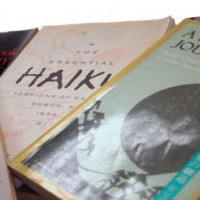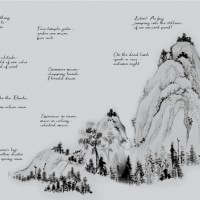Entertainment
A Haiku Primer: The Story of Basho & The Creation of the Form
- Details
- Published on Thursday, 01 March 2012 16:18
- Written by Kevin Kizer
During the Heian period of Japanese culture (700-1100), it was a social requirement to be able to instantly recognize, appreciate and recite Japanese and Chinese poetry. It was around this period that short forms of poetry (tanka) grew in popularity over long forms of poetry (choka).
The rigid lifestyles of the time carried over into art; every poem had to have a specific form. The approved form was the 5-7-5 triplet followed by a couplet of seven syllables (this was the Japanese equivalent to the iambic pentameter of Shakespeare's England).
From this form developed the renga (linked verse) and the kusari-no-renga (chains of linked verse). These forms were used almost as parlor games for the elite. However, in the mid-16th century there began a rise in "peasant" poetry. It was then that Japanese poetry underwent a rebirth in which the staid forms of the past were replaced with a lighter, airier tone. This new form was called haikai and was later named renku. It consisted of a beginning triplet called a hokku. The hokku was considered the most important part of the poem. It had two principal requirements: a seasonal word (kireji) and a "cutting word" or exclamation.
The Godfather of the Haiku
The Japanese poet Basho (1644-94) infused a new sensibility and sensitivity to this form in the late 17th century. He transformed the poetics and turned the hokku into an independent poem, later to be known as haiku. Basho's work focused around the concept of karumi (a feeling of lightness) – so much so that he abandoned the traditional syllabic limitations to achieve it.
Basho also was one of the earliest proponents of spontaneous prose. He believed in and preached the concept of Shasei (on-the-spot composition and tracing the subject to its origin). To give an idea of his influence, a contemporary school of haiku, Tenro, today remains popular all over Japan. It includes some 2,000 members all over the country who meet at designated temples to write as many as 100 haiku a day. The goal is to attempt to enter objects and share the "delicate life and feelings."
Since the time of Basho, the history of haiku mirrors the Zen ideal that it often relates. While it has gone through many transformations, developments, and revisions, good haiku today is surprisingly similar as to when Basho developed the form in the 17th century.
In the early centuries of Japanese history, there was a strong tradition of pilgrimage, particularly among poet-monks. This can be seen as a parallel to similar movements in medieval Europe and in America.
Some of the best known poet-monk-travelers include Sogi (1421-1502) and Saigyo (1118-90), as well as the Chinese poet Li Po (705-762). But it was Basho who perhaps had the greatest influence on those who followed him.
Before he was Basho
Born outside of Kyoto, Matsuo Kinsaku was the son of a low-ranking Samurai. Little is known of his early years. However, after writing verse as a child, Matsuo moved to Edo (present-day Tokyo) where he worked towards establishing himself as a writer. He quickly became a central figure in the burgeoning literary scene of Edo, writing numerous hundred-verse renkus (with another poet), presiding over haiku contests and producing anthologies of verse.
By the age of 34 Matsuo was recognized as a master and a circle of poets began to form around him. Ironically, it was at this time Matsuo began to recede from the scene. He moved to modest dwellings — a gamekeepers hut — outside of town. It was there that he received an unexpected gift that changed him: One of his students gave him a banana tree, or basho. The banana tree is a broad-leaved plant that tends to dwarf other plants around it. It also was an exotic tree, uncommon to Japan. Perhaps for these reasons, from that point on, Matsuo (who had used other pen names before) became known simply as Basho. Every hut he inhabited the rest of his life included a basho tree and he often traveled carrying one with him.
Basho's studies began to widen, encompassing much Chinese literature. He also shaved his head and began work as a lay-monk. He developed a love for solitude and it was then that his true poetic form began to present itself. He began to combine his influences, particularly the traditional forms of Japanese poetry with Zen-inspired aesthetics.
Much is known of his life as a poet as his followers took care to record as much about Basho as they could. They sensed his mastery. And in the last nine years of his life he experienced his most fertile period as a poet.
During this period, he also began his period of life on the road. He gave up virtually all his possessions and took to the countryside of Japan. He kept records of his travels in what he called his "sketchbooks". These included everything from direct recordings of the day's events, to haiku composed along the way, to fictionalized stories that he thought of as he traveled.
Basho achieved a realization during his travels, a satori where he sensed muga, which is the elimination of the self and the absorption of the self into what one is writing about. Of course, the master himself put it best.
One of his disciples, Doho, wrote: "The master said, 'Learn about a pine tree from a pine tree, and about a bamboo stalk from a bamboo stalk.'"
Basho taught that the poet should always detach the mind from the self and enter the object, "sharing its delicate life and feelings."
Each time Basho set off on a pilgrimage he would sell all he had, fully expecting that each trip would be his last. He referred to it as setting off into eternity. But each time he returned safely, with sketchbooks full of newly composed haiku and travel stories. And each time he returned his disciples would provide him with a home that included basho trees planted in the garden.
In 1694, Basho truly set off into eternity, this time on a trip to Japan's southwestern provinces. He grew gravely ill shortly into his trip and died of dysentery at the ripe old age of 50. He was buried in a temple at Otsu overlooking the lake he loved to gaze at, Lake Biwa.
This was his final haiku, written for the friends he was staying with at the time of his death:
Sick on a journey-
Over parched fields
Dreams wander on




















































